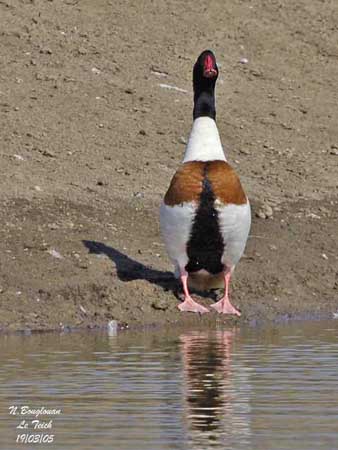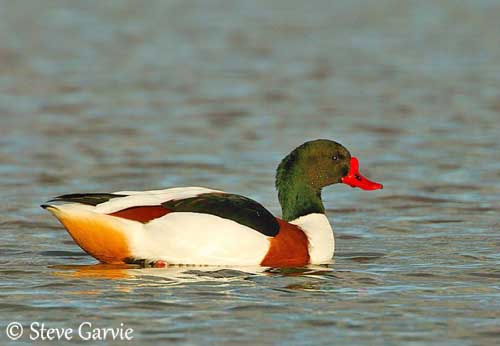
Fr: Tadorne de Belon
All: Brandgans
Esp: Tarro Blanco
Ital: Volpoca comune
Nd: Bergeend
Sd: Gravand
Photographers:
John Anderson
John Anderson Photo Galleries
Steve Garvie
RAINBIRDER Photo galleries
Ingo Waschkies
Bird Photography
Nicole Bouglouan
PHOTOGRAPHIC RAMBLE
Text by Nicole Bouglouan
Sources:
HANDBOOK OF THE BIRDS OF THE WORLD vol 1 by Josep del Hoyo-Andrew Elliot-Jordi Sargatal - Lynx Edicions - ISBN: 8487334105
ENCYCLOPEDIE DES OISEAUX DE FRANCE ET D’EUROPE – de Peter Hayman et Rob Hume - Flammarion – ISBN : 2082009920
GUIDE DES CANARDS, DES OIES ET DES CYGNES – de Steve Madge - Delachaux et Niestlé - ISBN: 2603013769
L’ENCYCLOPEDIE MONDIALE DES OISEAUX - Dr Christopher M. Perrins - BORDAS - ISBN: 2040185607
THE COMPLETE BOOK OF BRITISH BIRDS – Written by “Royal Society for the Protection of Birds” experts - Préface de Magnus Magnusson - Michael Cady- Rob Hume Editors - ISBN: 0749509112
BirdLife International (BirdLife International)
Pájaros de España (JL Beamonte)
Wikipedia, the free encyclopaedia
Common Shelduck
Tadorna tadorna
Anseriforme Order – Anatidae Family
INTRODUCTION:
The Common Shelduck is a large goose-like duck with contrasted plumage. This species has wide range, and can be found as well on cold mudflats in Scotland as on warm, reed-fringed Mediterranean wetlands.
DESCRIPTION OF THE BIRD:
Biometrics:
Length: 61-63 cm
Poids: 800-1450 g
The adult has black with green gloss head and neck. The body is white with several contrasting coloured markings. There is a bright chestnut band forming a broad collar from upper mantle to lower breast. Scapulars are black. On the upperwing, tertials are edged brown, secondaries are glossy green (a typical feature in all Tadorna species), and primaries are dark. The tail is white with black terminal band.

On the underparts, we can see a broad, blackish band from lower breast to vent. The undertail-coverts are chestnut. On the underwing, coverts are white whereas flight feathers are blackish.
The male has black head and neck, while the female shows whitish spots around the base of the bill. She has duller plumage overall and narrower breast band.
The male has bright red bill with conspicuous knob at base. The female has duller red bill and the knob is absent.
In both sexes, the eyes are dark brown. Legs and webbed feet are pale pink.
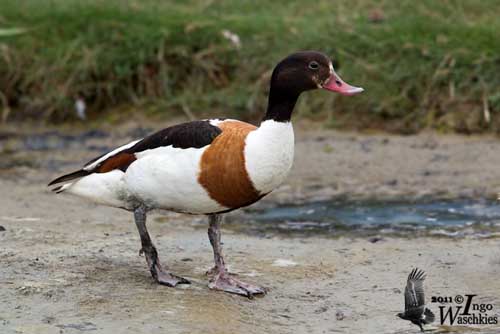
The non-breeding adults are duller and more greyish, with black and white markings on pectoral band and white spots in the face. The male has smaller knob. The white body feathers are narrowly edged brown.
The juvenile is duller than the non-breeding female and lacks the pectoral band. It has whitish face and foreneck. Its plumage is washed greyish overall, and it lacks the green glossy secondary feathers. Bill, legs and feet are greyish-blue.
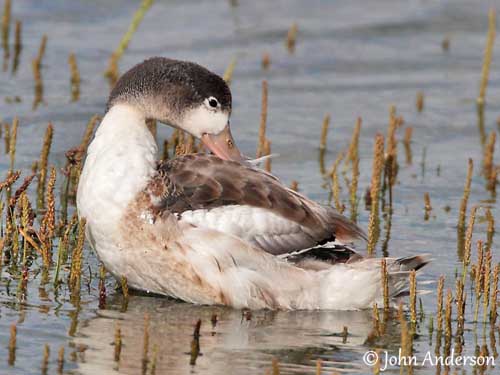
The chick has white down with dark markings on the upperparts.
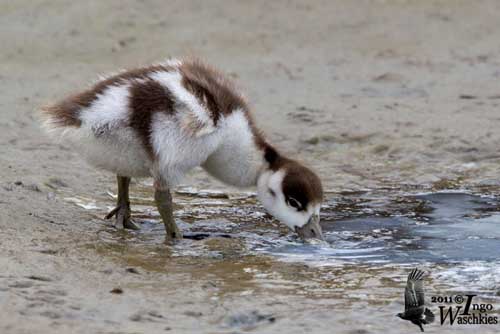
RANGE:
The Common Shelduck is found in coastal regions of NW Europe and scattered sites around the Mediterranean. It also occurs eastwards through Central Asia to NE China, and southwards to Iran and Afghanistan.
They gather in huge flocks at Helgoland Bight off NW Germany for moulting after the breeding season.
HABITAT:
The Common Shelduck frequents estuaries and mudflats, shores of salt and brackish water lakes, and usually occurs only in salt water, mainly in Europe. But it also needs fresh water for drinking.
In Asia, this species can be found on salt water inland lakes.
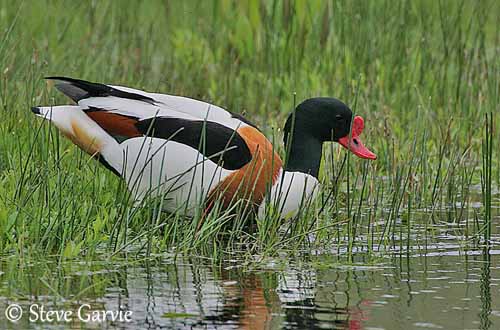
CALLS ANS SONGS: SOUNDS BY XENO-CANTO
The Common Shelduck is relatively silent outside the breeding season. But they become noisy as they gather in large numbers, especially for moulting. The most common sound is “ak-ak-ak” and a large variety of squawks.
During the breeding season, the males give clear whistles “uui…uu” or “uuiecheeuu”, and a deep, repeated “keu”.
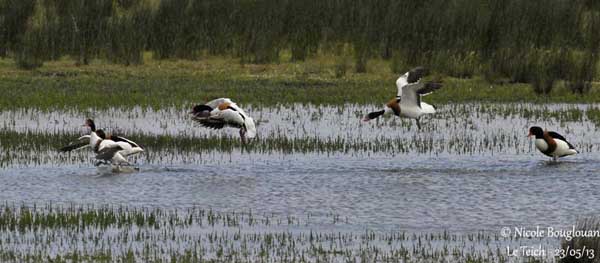
BEHAVIOUR IN THE WILD:
The Common Shelduck feeds on aquatic invertebrates such as molluscs, insects and crustaceans. In NW Europe, it takes salt-water snails (Hydrobia ulvae). But small fish, worms and plant materials are taken too.
It forages in shallow water by upending and head-dipping, and mostly by digging, scything and dabbling on mudflats.
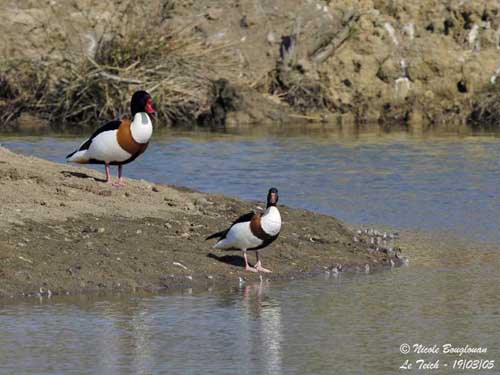
The Common Shelduck’s pair forms in autumn or early winter, but most of them can form mainly in January/February, when the males start to display.
Males often attack each other, as well in water as on land. Head and neck are lowered horizontally and towards the rival. They chase each other while calling and pecking while beating strongly their wings.
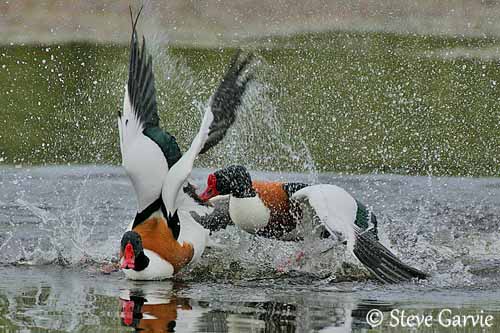
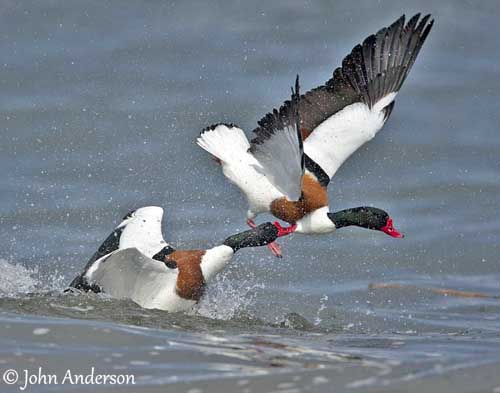
But most pairs persist from year to year. They move to their territorial feeding areas by late March. They regularly visit potential nest-sites and usually, several nests can be close together with no territory around the nest-site. They move after the chicks have hatched, and defend a kind of “mobile territory” around the chicks.
They moult after the breeding season and cannot fly for 25-30 days.
The Common Shelduck from the northern parts of the range and the inland populations move southwards and reach lower latitudes to winter.
The “moult migration” is made by flocks in a single file. They are powerful fliers and they perform fast wingbeats. On land, they walk quickly thanks to their fairly long legs.

REPRODUCTION OF THIS SPECIES:
The breeding season starts in April/June.
They can breed in isolated pairs or in small groups. The female chooses the nest-site, accompanied by the male. They nest in cavities in hollow trees or in burrows dug by rabbits. The nest is made with grass and moss, and is lined with down.
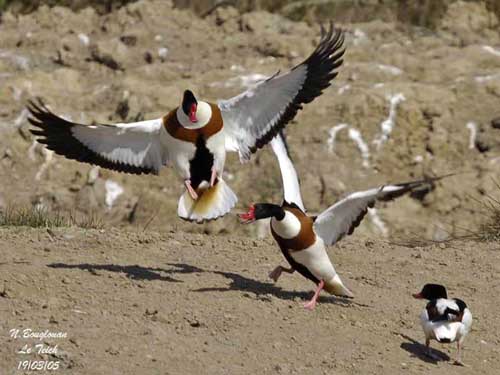
The female lays 8-10 creamy-white eggs. The incubation lasts 29-31 days by the female alone, while the male remains in the close vicinity of the nest.
The chicks leave the nest very soon after hatching, and sometime have to walk some distance to reach the water. Both parents lead them to the feeding areas and defend them against predators.
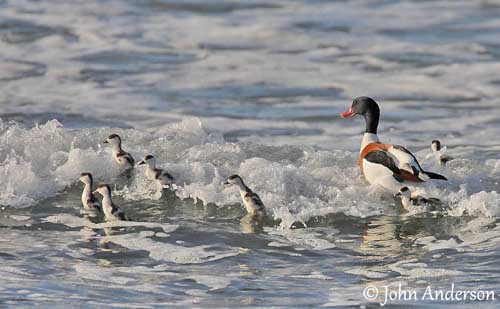
The chicks of a colony often form crèches where some adults guard them. They fledge about 45-50 days after hatching, and are independent as soon as they can fly.
Females are sexually mature at 2 years, and males at 4-5 years.
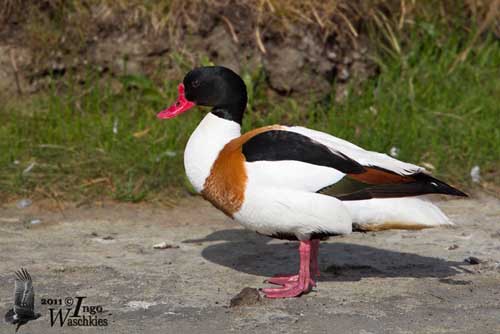
PROTECTION / THREATS / STATUS:
The populations of Common Shelducks appear stable and even increasing. However, this species is threatened by habitat loss and hunting in some parts of the range. They are vulnerable during the moulting period to diseases or natural disasters. But currently, this species is not threatened.
